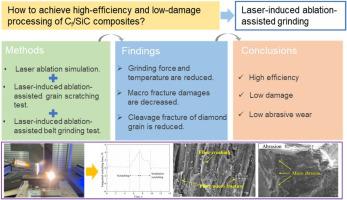Journal of Materials Processing Technology ( IF 6.3 ) Pub Date : 2022-01-13 , DOI: 10.1016/j.jmatprotec.2022.117503 Kun Zhou 1, 2 , Jiayu Xu 1 , Guijian Xiao 1, 2 , Yun Huang 2

|
Continuous fiber-reinforced ceramic matrix composites are promising materials for advanced hot end components and safety-critical components of aeronautics and astronautics; however, the difficult-to-process problem of these materials has been one of the technical bottlenecks restricting their high-performance service. The present work proposed a novel high-efficiency, low-damage, and low-abrasive wear processing method based on the chemical properties of the materials, which used lasers to ablate workpieces before grinding—laser-induced ablation-assisted grinding (LIAAG). The material removal mechanism of Cf/SiC composites was investigated by single-grain scratching tests; the grinding performances of LIAAG in terms of grinding force, grinding temperature, surface integrity, abrasive wear, grinding chips were evaluated by a contrast abrasive belt grinding test. It was found that Cf/SiC composites were chemically transformed into relatively loose and homogeneous ablation products (SiO2 and recrystallized SiC) at high laser ablation temperatures, which were easier to remove during grinding. In this case, surface morphologies displayed the microfracture and crushing of carbon fibers and SiC matrixes, and the grinding-induced damages, such as macro fracture, fiber pull-out, interface debonding, were significantly contained. Abrasive belt was primarily worn in micro-adhesion and micro-abrasion, rather than cleavage fracture and the fall-off in traditional grinding. Under optimum parameters, the grinding force, grinding temperature, and average surface roughness of belt grinding were reduced by 47 %, 40 %, and 26 %, respectively. Consequently, the surface integrity was improved greatly, and the abrasive wear was reduced significantly. The work provides a vital high-performance processing method for ceramic matrix composites components.
中文翻译:

一种新型的Cf/SiC陶瓷基复合材料低损伤低磨损加工方法:激光诱导烧蚀辅助磨削
连续纤维增强陶瓷基复合材料是用于航空航天先进热端部件和安全关键部件的有前途的材料;然而,这些材料的难加工问题一直是制约其高性能服务的技术瓶颈之一。本工作提出了一种基于材料化学性质的新型高效、低损伤、低磨粒磨损加工方法,即在磨削前使用激光烧蚀工件——激光诱导烧蚀辅助磨削(LIAAG)。C f的材料去除机理/SiC复合材料通过单晶划痕试验研究;LIAAG 在磨削力、磨削温度、表面完整性、磨粒磨损、磨屑方面的磨削性能通过对比砂带磨削试验进行评估。发现C f /SiC复合材料化学转化为相对松散和均匀的烧蚀产物(SiO 2和再结晶的 SiC)在高激光烧蚀温度下,在研磨过程中更容易去除。在这种情况下,表面形貌表现出碳纤维和SiC基体的微断裂和压碎,并且显着地抑制了磨削引起的损伤,如宏观断裂、纤维拔出、界面脱粘。砂带磨损主要是微粘着和微磨,而不是传统磨削中的解理断裂和脱落。在最佳参数下,砂带磨削的磨削力、磨削温度和平均表面粗糙度分别降低了47%、40%和26%。因此,表面完整性大大提高,磨粒磨损显着降低。


























 京公网安备 11010802027423号
京公网安备 11010802027423号